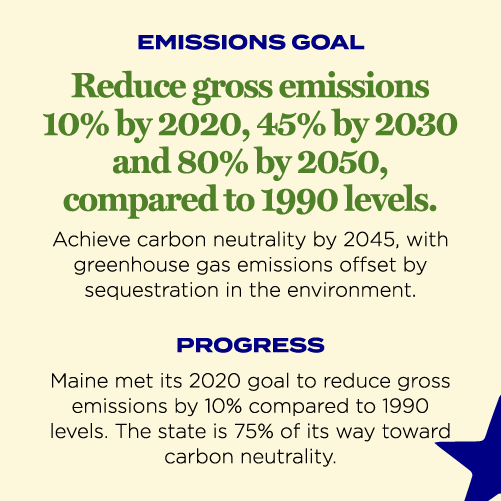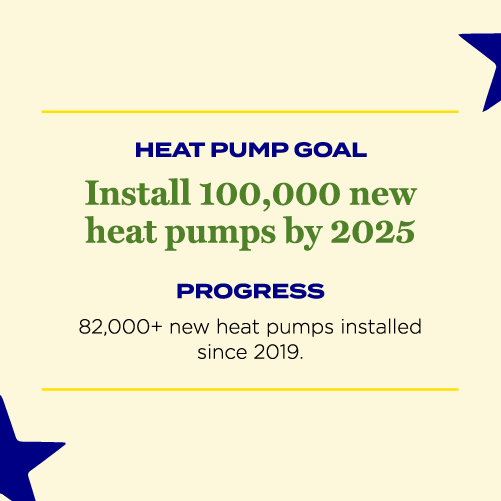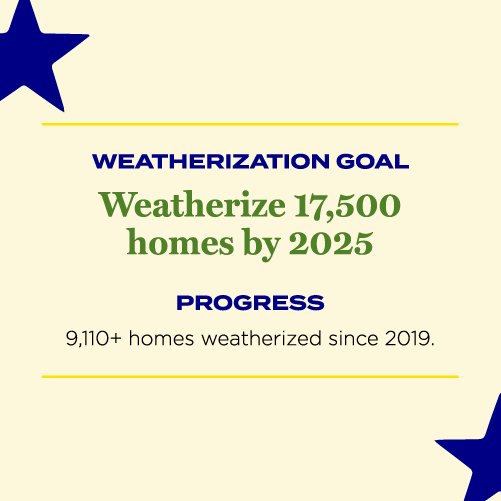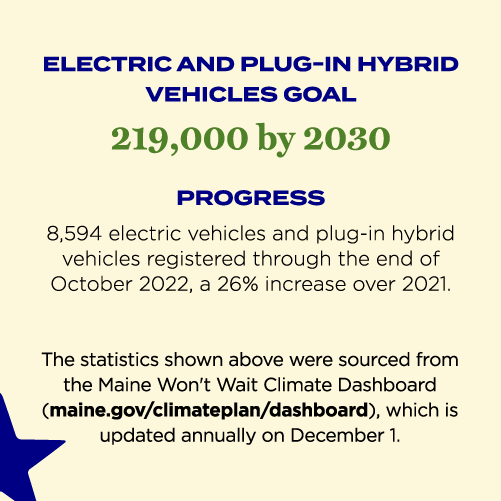Vision 2050: Maine's road to climate neutrality
A progress report on “Maine Won’t Wait” state climate plan goals and a collective imagining of Maine’s future
By Amy Paradysz
The future is here—at least when it comes to measuring our state’s progress toward the “Maine Won’t Wait” state climate plan goals introduced in December 2020. In the following interview, Hannah Pingree, director of the Governor’s Office of Policy Innovation and the Future, gives us a progress report on the goals, which include heat pump installations, weatherization and “greener” building products, land conservation, and increasing the use of electric and hybrid vehicles. Each goal is tied to Maine’s aggressive carbon reduction goals, which have due dates in 2030 and 2050.
We also hear from 17 climate-focused Mainers, including nonprofit leaders, activists, scholars and consultants, who reflect on what’s succeeding with these initiatives and what else needs to happen to solve Maine’s most important long-term climate-related challenges. Several of these changemakers share their vision—goals with hope attached—for Maine over the next generation.
Interview with Hannah Pingree
Director of Maine Governor’s Office of Policy Innovation and the Future
This interview was conducted by Amy Paradysz / Green & Healthy Maine HOMES on Jan. 18, 2023, via Zoom.
Would you say that “Maine Won’t Wait” is about making proactive goals that, taken together, reduce our emissions and combat climate change?
HANNAH PINGREE, DIRECTOR OF THE GOVERNOR’S OFFICE OF POLICY INNOVATION AND THE FUTURE
Yes. The Climate Plan is two things: reducing our emissions to meet our state goals and preparing Maine for climate changes. Recent storms have shown us that we have infrastructure that isn’t ready. We are making good progress in partnering with communities and emergency management agencies to do more to prepare, but climate change is here and having adverse impacts. We need to do more.
The causeway that connects Little Deer Isle to Deer Isle in Stonington is vulnerable during heavy rain. Photo: Maine Department of Transportation.
Infrastructure in terms of the power network?
PINGREE: Yes, poles and wires. But also roadways, bridges, piers, wastewater treatment plants and stormwater systems. Significant weather and precipitation wash out culverts and roads, and this has significant impact on people’s lives. As an example, the Maine Department of Transportation is working closely with the towns of Stonington and Deer Isle around the causeway that connects Little Deer Isle to Deer Isle to Stonington, which was inundated during a recent storm. In upgrading our transportation infrastructure, we’re in a race that requires significant funding, partnership with towns and a lot of advance planning.
Like the work that the Gulf of Maine Research Institute (GMRI) is doing with Union Wharf on the Portland waterfront, calculating how much they need to raise the wharf to account for sea level rise?
PINGREE: Absolutely. We are a state of many coastal communities with a lot of coastal infrastructure. Consider GMRI’s planning around that one pier and take that to every coastal community. And climate change isn’t just a coastal problem. We have inland communities that are dealing with greater river flooding and rainstorms washing out areas. We’ve been working with the town of Winslow, for example, because areas of the town keep flooding.
The report is called “Maine Won’t Wait,” but—the way you’re describing it—Maine can’t wait, because the impacts are already coming.
PINGREE: “Maine Won’t Wait”—the governor coined that term when she was saying that Maine would do our part on emissions reduction. But definitely, Maine cannot wait when it comes to planning for impacts. We initiated a state program, the Community Resilience Partnership, to help towns do climate planning. Those programs emphasize engaging with people in town—what are they seeing and what do they want to be proactive about? More than 125 towns are engaged in this.
The federal government is funding significant infrastructure in communities—drinking water, wastewater, road systems and public transportation. Communities that are preared with infrastructure projects have the opportunity to receive at least partial funding from the Federal Infrastructure Bill.
It’s a great time to take action, but it all requires leadership and people who care about climate change and want to see their community be prepared and safe.
Looking at the emissions-related goals, can you walk us through a bit of a progress report?
PINGREE: It all comes down to emissions. The Maine Department of Environmental Protection measures emissions every two years, and their report tells us: What is the atmosphere seeing from the emissions from our homes, our transportation and our industrials? As the most recent emissions report [in 2022] showed, transportation and buildings are our two biggest sources of emissions.
How are we doing on our goals for those two biggest sources of emissions? Where are we doing well?
PINGREE: In our building sector, we’ve set aggressive goals around the electrification of our buildings, especially around using heat pumps. The governor set a goal of 100,000 new heat pumps by 2025, and we’re on track to reach it this year. We’re leading the country in delivery of heat pumps. For homeowners, heat pumps are a win-win. It is an efficient technology that can be a cheaper way to heat your home. And this industry produces good-paying jobs.
We’re also on track with weatherization, although that’s more of a slog and requires heavy lifting on the part of contractors in people’s homes.
These heating-related goals are important in a state like Maine, which is an outlier in terms of our reliance on oil to heat our homes. We’re currently contemplating how to make those goals more aggressive.
We give a lot of credit to Efficiency Maine’s incentive programs, which include state and federal funding, and MaineHousing, which has federal funding for weatherization and heat pumps.
What’s a goal where we have a long way to go?
PINGREE: Transportation emissions. We’re a state where many of us live in rural areas, where it’s more of a challenge to make electrified or public transportation work. We have aggressive goals for electrified transportation and reducing the amount that people have to drive. But that takes a supply chain of vehicles that are affordable for people and more locations for people to charge vehicles in northern and eastern Maine. We’re making progress. Maine Department of Transportation is working with us on getting fast chargers for EVs across rural Maine. From the national automakers, we need four-wheel drive EVs that are affordable that we can depend on in the winter.
What can regular people do to help Maine reach our climate change goals?
PINGREE: It’s a great time to take climate action because you care about this issue, but also because it’s a potential cost-saver. Whether you’re paying your electricity or heating bills, or buying gasoline, there are lots of opportunities. Look at the rebates at Efficiency Maine to weatherize, install a heat pump or buy an EV. Putting more insulation in your attic or a vapor barrier in your basement can improve your quality of life, and there are ways to help you pay for these improvements. In addition to these state incentives, Inflation Reduction Act programs are bringing significant new federal tax incentives for the installation of renewable energy, heat pumps and more efficient appliances and EVs.
What other innovations do you see as opportunities in the battle against climate change?
PINGREE: I think we’re seeing a renaissance of wood products companies coming to Maine, from LP Building Products in Houlton to GO Lab’s TimberHP wood-fiber insulation products in Madison.
Why do wood products help?
PINGREE: The state of Maine is 90% forested, and having an active and healthy forest and sequestering that carbon is important for our climate neutrality goals. When you use a wood product to build a home that will last 100-plus years, as opposed to burning [the wood], that’s a long-term opportunity to embody carbon while keeping a vibrant sector of our economy going.
As the region and the nation look to embody carbon in construction, as opposed to using steel, concrete and insulation made with fossil fuels, there’s a large economic opportunity for Maine. GO Lab is also revitalizing a mill and bringing jobs to a region that needs those jobs, and they use a wood product that is a byproduct of papermaking or other lumber operations.
The Gulf of Maine Research Institute bought Portland Harbor’s Union Wharf in 2021 to protect and preserve waterfront access in Portland Harbor, modeling how coastal communities can invest in their waterfronts and protect them from sea level rise. Photo: Gulf of Maine Research Institute.
Reflecting on Maine’s Climate Goals & Progress
Responses edited for length and clarity.
Dan Burgess
“Maine was recognized in December 2022 as one of the top states for energy efficiency, which shows how Maine people are taking strong action to help save money and reduce emissions by weatherizing their homes, installing more efficient appliances, switching to high-efficiency heat pumps and more. In the years ahead, the Governor’s Energy Office is working on many exciting initiatives to further reduce our reliance on expensive, imported fossil fuels by responsibly expanding renewable energy sources in Maine, such as solar, onshore wind and offshore wind; working regionally to make significant investments in our electrical grid to support clean energy; and advancing new technologies like battery storage and clean hydrogen that can scale our clean energy goals even more. With some of the most ambitious renewable energy targets in the country—including a goal of using 100% clean energy in Maine by 2050—and now [recognition as a] leader in efficiency, Maine is not waiting to address climate change, become more energy independent, and seize the environmental, economic and public health benefits that will come from our clean energy transition.”
Dan Burgess is director of the Maine Governor’s Energy Office and serves on the Board of the Efficiency Maine Trust and the Board of the National Association of State Energy Officials.
Dr. Sharon Klein
“Maine Won’t Wait is an impressive climate action plan produced through an iterative stakeholder-engaged process. Even more impressive, it is active guidance for action. The Maine Won’t Wait Dashboard is a hub of information with useful graphs, maps and data directly related to the plan’s goals to help all Mainers see the progress toward meeting those goals in action. This type of transparency and data access is important to ensuring Maine holds itself accountable for the goals specified in the plan. As a service provider for the Community Resilience Partnership, I especially like the ability to see where specific projects are happening, so I can follow their development and connect with others in the Partnership to learn from one another. Through the Partnership, I hope the many benefits associated with a transition to clean energy will directly impact individual Maine communities in a positive way in the short and long term, especially those historically underserved or particularly vulnerable to climate change effects.”
Dr. Sharon Klein is an associate professor in the School of Economics at the University of Maine; a board member of the weatherization nonprofit WindowDressers; and a service provider for the Maine Community Resilience Partnership.
Michael Stoddard
“We have seen that adding one or two heat pumps is a very popular and effective solution to heat a part of a home or business. But Mainers will see even better savings if they convert their entire system over to heat pumps. Our research shows that 1 in 5 new homes built in Maine are heating entirely with heat pumps; they are not installing a furnace or boiler. This is the wave of the future.”
Michael Stoddard is executive director of the Efficiency Maine Trust, the independent administrator for programs that promote energy efficiency, alternative energy resources and carbon savings in Maine, including rebates for heat pumps and incentives for weatherization.
Shenna Bellows
“I believe in leading by example. That’s why, whether in my personal car or using my work car for state business, I’m in an electric vehicle. We were also proud to install electric vehicle chargers at multiple Bureau of Motor Vehicle locations to contribute to Maine’s charging infrastructure. These are small steps forward that we can take to support Maine’s efforts to reduce carbon emissions.”
As Maine Secretary of State, Shenna Bellows oversees the Maine Bureau of Motor Vehicles.
Kate Dempsey
“Mainers have long understood the importance of protecting the natural places that make our state so special, including the forests that sustain our rural communities and economy. Today, 22% of Maine land is in conservation, with most of that acreage provided by conservation easements on private forest lands that support timber harvests. We need to increase conserved lands by [about] one percentage point each year in order to achieve our goal of conserving 30% of the state by 2030. The conservation community is already hard at work—collaborating with state and federal agencies, Wabanaki Tribes, landowners and communities around Maine—in pursuit of this critical milestone.”
Kate Dempsey is state director of The Nature Conservancy in Maine and a member of the Maine Climate Council.
Jeff Marks
“A growing number of companies understand the magnitude of the climate challenges we are confronting and are ready to act. Every day, more entrepreneurs and business leaders are seeing the opportunities that climate change is bringing to build new companies and reinvent existing ones, all of which will create new jobs and a more sustainable economy for the future.”
Jeff Marks is the executive director of ClimateWork Maine and has worked for more than 20 years at the intersection of business, government and the economy.
Troy Moon and Julie Rosenbach
“In Portland and South Portland, our joint climate action plan, One Climate Future, guides our work to make our cities resilient and sustainable, now and in the future. Our plan envisions a future with complete streets equipped to accommodate all modes of travel, on foot, by bike, on transit or in a car; a robust electric vehicle charging network; and frequent, accessible public transportation. We’re working to create complete neighborhoods where residents can live within a short walk or bike ride to parks, shops or work. We’re working to help people electrify their homes to reduce energy costs and carbon emissions, and to make our homes resilient to extreme heat. To do this, we are equipping our communities with resources to adapt to changing climate conditions.”
Troy Moon and Julie Rosenbach are the sustainability directors for the City of Portland and the City of South Portland, respectively. Together they lead the One Climate Future team.
Imagining the Future
WHEN GOVERNOR JANET MILLS created the Office of Policy Innovation and the Future, she was inspired by novelist Kurt Vonnegut, who once suggested governments ought to have executives focused on the future. Revolutionary change of the type needed to meet all the goals in the Maine Won’t Wait plan—including growing the grid to meet increased demand—requires some visionaries. Looking to the future, we hear from Mainers advocating for systems transformation as a path to sustainable transportation and construction, healthier ecosystems, and climate justice.
Responses edited for length and clarity
Fred Horch
“Within 25 years, if we make wise investments now, every building and vehicle in Maine will be fully electric and powered by clean energy. Today’s solar panels, batteries, electric motors and computers are already sufficient for the task and will continue to improve, delivering more value from every ray of sunshine illuminating Maine. Homeowners can optimize, electrify and solarize their homes. Many have the resources to reach 100% clean energy today; others will need to make smaller investments over many years.”
Fred Horch is Volunteer Project Director of the nonprofit, businessled Maine initiative “On The Pathway To 100% Clean Energy” and cofounder of Spark Applied Efficiency.
Amara Ifeji
“My vision for Maine in the next 25 years is one where education is used as a tool to build a more just and healthy state. Community engagement will be centered to foster deeper environmental awareness and appreciation, which will translate to action leading to local solutions in energy, environmental and climate justice.”
Amara Ifeji is Director of Policy at the Maine Environmental Education Association, where she contributes to and advances legislative solutions focused on systemic transformation.
Naomi CO Beal
“In my vision for carbon neutrality, we in Maine will have offered funding and technical support for all Mainers to live in combustion-free, well insulated and air-sealed buildings that will be comfortable and resilient in extreme weather. Retrofitting of existing buildings will be well understood, and the life cycle of buildings will be included in initial low/no-carbon design. Concepts such as buildings as material banks will be part of building code and zoning, and public transportation will enhance bikeable, walkable communities with environmental protections for wild space and native flora and fauna.”
Naomi CO Beal is the executive director of passivhausMAINE, celebrating its 10th year.
Marvin Cling, Sr.
“I envision an environment that is not disconnected. One way to achieve a more connected ecosystem is to let the alewives run in the millions on the St. Croix River. Fish passages have to be improved [to] accommodate all sea-run fish that need to migrate upstream to spawn, and also allow safe passage back to the ocean. Alewives are a key species that feed many other species. A robust and productive Gulf of Maine is needed to rely less on commercial food production and distribution that comes from somewhere else. In 2050, with millions of alewives running up the St. Croix, there will be more groundfish. Food sovereignty and sustenance is vital and important for people to reconnect to a more vibrant and healthier ecosystem.”
Marvin Cling, Sr. is a tribal environmental professional employed by a federally recognized tribe in Maine and is Diné from Arizona.
Ezra Sassaman
“At Maine Youth for Climate Justice, we view the climate crisis through a climate justice lens. This framework recognizes that the crisis has disproportionate effects on different groups, with those who have contributed the least to the problem suffering the most. Youth and marginalized voices must lead conversations and decisions around mitigating the climate crisis. We do not want the same broken systems and power hierarchies that caused the climate crisis to attempt to fix the same problem they created. We are instead hoping to see systems change as we address the crisis and create a shared future [that] youth feel hopeful and excited about.”
Ezra Sassaman of Bar Harbor is the Advocacy and Organizing Coordinator for Maine Youth for Climate Justice.
Craig Saddlemire
“To successfully achieve our goal of carbon neutrality, we need to collectively treat our homes and transportation infrastructure as one integrated system. Both are extensions of the land, which is scarce and should be treated as a public resource rather than a private commodity. Understanding this all as one public system in need of collective stewardship, we need to uphold the human right to housing while also deeply embracing the smart growth principles of density, mixed-use and contextually responsive architecture. This effort will take a substantial cultural, political and economic shift. It requires us to think about our homes as something beyond personal property. It requires us to think about the public implications and conflicts inherent in real estate, human rights and our shared ecosystem.”
Craig Saddlemire is co-founder of Raise-Op Housing Cooperative, Maine’s oldest urban affordable housing cooperative, and developer of Lewiston’s first passive house apartment building.
Zoe Miller
“I envision a Maine where investments in public transportation, safer streets and affordable electric vehicles vastly reduce transportation-related carbon emissions, while also improving the lives of older Mainers, Mainers with disabilities, Mainers with low incomes, and Mainers who are Black, Indigenous, or other people of color. Realizing such a vision will require that decision makers use an equity lens when making investments. This means committing to charging stations that are accessible for people of all ages and abilities and investing in frequent and dependable public transportation of all shapes and sizes, especially in rural parts of the state.”
Zoe Miller facilitates the Moving Maine Network, a statewide coalition devoted to improving access to community and opportunity for all Mainers through improved mobility.
Sara Shifrin
“The state’s unique mountain and coastal landscapes continue to attract new residents, many of whom are opting for hybrid work arrangements and experiencing robust learnfrom-home opportunities for their children. However, many homes lack the necessary infrastructure to support a home office, schooling spaces or electric vehicle charging. Maine can transform its 259 public libraries into community hubs, providing high-speed internet, EV charging stations, remote classrooms and shared workspaces. This allows residents to work and live in Maine, regardless of the limitations of their homes.”
Sara Shifrin is director of innovation at the Marlon Family IDEAS Center at Gould Academy in Bethel.
Sarah Cushman
“Community will be our saving grace amidst the climate crisis—plus, liberate those of us who experience transportation barriers. And we can start today. Look for who’s struggling to get somewhere in your community. Sign up with your local volunteer driver program—or help start one! Contact the UMaine Center on Aging for their program list and toolkit. Carpool with a neighbor to the grocery store, to events, to work—even once a week or twice a month. Join Go Maine and post your ride there. Help someone get a reduced-fare bus pass. Become a Community Spoke with the Bicycle Coalition of Maine and advocate for better sidewalks and crossings in your village area and to local services, retirement homes and schools. Work on a nearby trail connecting these places. Help get more folks on bikes who need them. Donate cash, time or your old bike to Apex Bike Factory in Biddeford, the Bangor Earn-a-Bike Program, Bikes for All Mainers at Portland Gear Hub, or the Diversified Occupations Bike Shop at Oxford Hills. And with all these efforts we connect—with people around us, where we live, the natural world that sustains our daily lives. We renew ourselves while we knit our communities tighter together for the road ahead.”
Sarah Cushman is a transportation consultant and former co-chair of the Transportation Working Group of the Maine Climate Council.
Lisa Whited
“People living and working in Maine will know that they have everything they need. We will be living in a true circular economy and will participate in sharing and paying for use (instead of purchasing new things). We will experience abundance, not scarcity. We will have returned to many of the frugal ways of our grandparents and great-grandparents because we treasure Maine's natural resources, clean air and pure water.”
Lisa Whited is a certified Circular Economy Specialist and the author of "Work Better. Save the Planet: The Earth-First Workplace Is Good for People, Great for Business."
Martin Grohman
“Two decades from now, we’ll have developed the ability to deliver affordable clean energy every hour of the year. The hard truth is that net zero sounds good, but it's actually a dangerous trap that doesn't necessarily reduce fossil fuel usage. 24/7 clean energy is a much more difficult but much more important goal. In fact, right now, no matter how much renewable energy we generate, we don’t make it at the right times. That renewable energy generated when we don’t need it often goes to waste, and yet we still burn a lot of fossil fuel during bad weather and through long hot or cold spells. It all adds up, so that more than two-thirds of our electrical energy supply is still from fossil fuel, so we've got work to do! It will take policy, markets and technology together to get there, but it will have outsize benefits once we do.”
Martin Grohman is executive director of the Environmental & Energy Technology Council of Maine (E2Tech).
This article appeared in the Spring 2023 edition of Green & Healthy Maine HOMES. Subscribe today!
Find Maine experts that specialize in healthy, efficient homes in the Green Homes Business Directory.




























